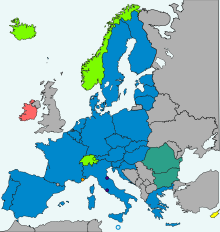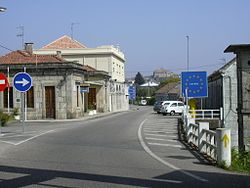Schengen Agreement
| Agreement between the Governments of the States of the Benelux Economic Union, the Federal Republic of Germany and the French Republic on the gradual abolition of checks at their common borders | |
|---|---|
 Signatures of the Schengen Agreement on 14 June 1985 | |
| Signed | 14 June 1985 (39 years, 7 months and 10 days ago) |
| Location | Schengen, Luxembourg |
| Effective | 26 March 1995 (29 years, 9 months and 29 days ago) |
| Original signatories | |
| Parties | |
| Depositary | Government of the Grand Duchy of Luxembourg |
| Full text | |
The Schengen Agreement (English: /ˈʃɛŋən/ SHENG-ən, Luxembourgish: [ˈʃæŋən] ⓘ) is a treaty which led to the creation of Europe's Schengen Area, in which internal border checks have largely been abolished. It was signed on 14 June 1985, near the town of Schengen, Luxembourg, by five of the ten member states of the then European Economic Community. It proposed measures intended to gradually abolish border checks at the signatories' common borders, including reduced-speed vehicle checks which allowed vehicles to cross borders without stopping, allowing residents in border areas freedom to cross borders away from fixed checkpoints, and the harmonisation of visa policies.[1]
In 1990, the Agreement was supplemented by the Schengen Convention which proposed the complete abolition of systematic internal border controls and a common visa policy. The Schengen Area operates very much like a single state for international travel purposes with external border controls for travellers entering and exiting the area, and common visas, but with no internal border controls. It currently consists of 29 European countries covering a population of over 450 million people and an area of 4,595,131 square kilometres (1,774,190 sq mi).[2]
Originally, the Schengen treaties and the rules adopted under them operated independently from the European Union. However, in 1999 they were incorporated into European Union law by the Amsterdam Treaty, while providing opt-outs for the only two EU member states that had remained outside the Area: Ireland and the United Kingdom (which subsequently withdrew from the EU in 2020). Schengen is now a core part of EU law, and all EU member states without an opt-out which have not already joined the Schengen Area are legally obliged to do so when technical requirements have been met. Several non-EU countries are included in the area through special association agreements.[3]
History

Free movement of people was a core part of the original Treaty of Rome and, from the early days of the European Economic Community, nationals of EEC member states could travel freely from one member state to another on production of their passports or national identity cards.[4] However, systematic identity controls were still in place at the border between most member states.[citation needed]
Disagreement between member states led to an impasse on the abolition of border controls within the Community, but in 1985 five of the then ten member states – Belgium, France, Luxembourg, the Netherlands, and West Germany – signed an agreement on the gradual abolition of common border controls. The agreement was signed on the Princess Marie-Astrid boat on the river Moselle near the town of Schengen, Luxembourg,[5] where the territories of France, Germany and Luxembourg meet. Three of the signatories, Belgium, Luxembourg, and the Netherlands, had already abolished common border controls as part of the Benelux Economic Union.[citation needed]

The Schengen Agreement was signed independently of the European Union, in part owing to the lack of consensus amongst EU member states over whether or not the EU had the jurisdiction to abolish border controls,[6] and in part because those ready to implement the idea did not wish to wait for others (at this time there was no enhanced co-operation mechanism). The Agreement provided for harmonisation of visa policies, allowing residents in border areas the freedom to cross borders away from fixed checkpoints, the replacement of passport checks with visual surveillance of vehicles at reduced speed, and vehicle checks that allowed vehicles to cross borders without stopping.[1]
In 1990, the Agreement was supplemented by the Schengen Convention which proposed the abolition of internal border controls and a common visa policy. It was this Convention that created the Schengen Area through the complete abolition of border controls between Schengen member states, common rules on visas, and police and judicial cooperation.[citation needed]
The Schengen Agreement and its implementing Convention were enacted in 1995 only for some signatories,[which?] but just over two years later during the Amsterdam Intergovernmental Conference, all European Union member states except the United Kingdom and Ireland had signed the Agreement. It was during those negotiations, which led to the Amsterdam Treaty, that the incorporation of the Schengen acquis[7] into the main body of European Union law was agreed along with opt-outs for Ireland and the United Kingdom (which subsequently withdrew from the EU in 2020), which were to remain outside of the Schengen Area.[8]

In December 1996, two non-EU member states, Norway and Iceland, signed an association agreement with the signatories of the Agreement to become part of the Schengen Area. While this agreement never came into force, both countries did become part of the Schengen Area after concluding similar agreements with the EU.[9] The Schengen Convention itself was not open for signature by non-EU member states.[10] In 2009, Switzerland finalised its official entry to the Schengen Area with the acceptance of an association agreement by popular referendum in 2005.[11]
Now that the Schengen Agreement is part of the acquis communautaire, it has, for EU members, lost the status of a treaty, which could only be amended according to its terms. Instead, amendments are made according to the legislative procedure of the EU under EU treaties.[12] Ratification by the former agreement signatory states is not required for altering or repealing some or all of the former Schengen acquis.[13] Legal acts setting out the conditions for entry into the Schengen Area are now made by majority vote in the EU's legislative bodies. New EU member states do not sign the Schengen Agreement as such, instead being bound to implement the Schengen rules as part of the pre-existing body of EU law, which every new entrant is required to accept.[citation needed]
This situation means that non-EU Schengen member states have few formally binding options to influence the shaping and evolution of Schengen rules; their options are effectively reduced to agreeing or withdrawing from the agreement. However, consultations with affected countries are conducted prior to the adoption of particular new legislation.[14]
In 2016, border controls were temporarily reintroduced in seven Schengen countries (Austria, Denmark, France, Germany, Norway, Poland, and Sweden) in response to the European migrant crisis.[15][16]
Portugal reintroduced checks several times along its border with Spain, during the UEFA Euro 2004 championships and when Portugal hosted the NATO 2010 Lisbon summit. Portugal also reintroduced border checks from 10 May 2017 to 14 May 2017, during Pope Francis's visit to Fátima, Portugal.[17]
Border controls were reintroduced throughout the area during the COVID-19 pandemic.[18]
On 8 December 2022, the Justice and Home Affairs Council voted to admit Croatia to the Schengen Area, effective from 1 January 2023.[19]
On 30 December 2023, the Justice and Home Affairs Council agreed to partially include Bulgaria and Romania in the Schengen Area, with air and maritime border checks lifted from 31 March 2024.[20] On 12 December 2024, the Council decided to lift the remaining border checks at land crossing effective 1 January 2025, making Bulgaria and Romania full members of the Schengen Area.[21]
See also
- Central America-4 Border Control Agreement
- eu-LISA
- European Neighbourhood Policy
- Internal market
- Prüm Convention
Notes
References
- ^ a b Respectively Articles 2, 6 and 7 of the Schengen Agreement, EUR-Lex; accessed 27 January 2016.
- ^ Schengen Visa Information. "Schengen Area Countries". Schengen Visa Information. Retrieved 17 November 2019.
- ^ Anonymous (6 December 2016). "Schengen Area – Migration and Home Affairs – European Commission". Migration and Home Affairs – European Commission.
- ^ Council Directive on administrative practices and procedures concerning settlement, employment and residence in a Member State of the Community of workers and their families from another Member State (OJ 80, 13 December 1961, p. 1513.)
- ^ Lungescu, Oana. "Fortress Europe". British Broadcasting Corporation. Retrieved 13 April 2013.
- ^ Craig, Paul; Gráinne de Burca (2003). EU Law: Text, Cases and Materials (3rd ed.). Oxford: Oxford University Press. p. 751. ISBN 0-19-924943-1.
- ^ The complete acquis, including the fundamental Agreement and Convention and some subsequent acts and instruments brought about meanwhile in its legal framework, had been published here: "Official Journal of the European Communities – The Schengen Acquis" (PDF). 22 September 2000. Retrieved 25 November 2007..
- ^ "Schengen Area Countries List – Schengen Zone". Schengen VISA Information. Retrieved 28 July 2017.
- ^ "EUR-Lex – 21999A0710(02) – EN – EUR-Lex". eur-lex.europa.eu. 18 May 1999. Retrieved 24 October 2020.
- ^ Article 140 of the Schengen Convention.
- ^ Allen M. (March 2009). Switzerland's Schengen entry finally complete. swissinfo.ch; retrieved 14 June 2013.
- ^ At first the Council of the European Union (later the European Parliament and the Council of the European Union in the codecision procedure) took the place of the Executive Committee that had been created under the agreement Council Decision of 22 December 2004 providing for certain areas covered by Title IV of Part Three of the Treaty establishing the European Community to be governed by the procedure laid down in Article 251 of that Treaty
- ^ Example: By article 39 subsection 1 of the Schengen Borders Code, Articles 2 to 8 of the Schengen Agreement had been repealed – "Regulation (EC) No 562/2006 of the European Parliament and of the Council of 15 March 2006 establishing a Community Code on the rules governing the movement of persons across borders (Schengen Borders Code)" (PDF). 13 April 2006. Retrieved 25 November 2007..
- ^ "The Schengen area and cooperation". Summaries of EU legislation. European Commission. Retrieved 4 April 2013.
In practice, this involvement takes the form of mixed committees that meet alongside the working parties of the EU Council. They comprise representatives of the Member States' governments, the Commission and the governments of third countries. Associated countries therefore participate in discussions on the development of the Schengen acquis, but do not take part in voting. Procedures for notifying and accepting future measures or acts have been laid down.
- ^ "Schengen: Controversial EU free movement deal explained – BBC News". BBC News. 26 April 2011. Retrieved 6 June 2016.
- ^ "DGs – Migration and Home Affairs – What we do – ...Schengen Area – Reintroduction-border-control". ec.europa.eu. Retrieved 6 June 2016.
- ^ "Portugal declares Papal holiday". Retrieved 28 April 2017.
- ^ "Europe Barricades Borders to Slow Coronavirus". The New York Times. 17 March 2020. Archived from the original on 17 March 2020.
- ^ "Schengen area: Council decides to lift border controls with Croatia". Consilium. Retrieved 12 December 2024.
- ^ "Schengen area: Council agrees to lift air and maritime internal border controls with Bulgaria and Romania". Consilium. Retrieved 12 December 2024.
- ^ "Schengen: Council decides to lift land border controls with Bulgaria and Romania". Consilium. Retrieved 12 December 2024.
External links
- Agreement between the Governments of the States of the Benelux Economic Union, the Federal Republic of Germany and the French Republic on the gradual abolition of checks at their common borders – The Schengen Agreement
- Convention implementing the Schengen Agreement of 14 June 1985 between the Governments of the States of the Benelux Economic Union, the Federal Republic of Germany and the French Republic on the gradual abolition of checks at their common borders – Convention implementing the Schengen Agreement
- Schengen Archived 16 July 2014 at the Wayback Machine – eurotopics
- The Schengen Area: collection of resources (texts, images, videos,...) – CVCE – Virtual Resource Centre for Knowledge about Europe
- The Schengen Acquis – EUR-Lex
